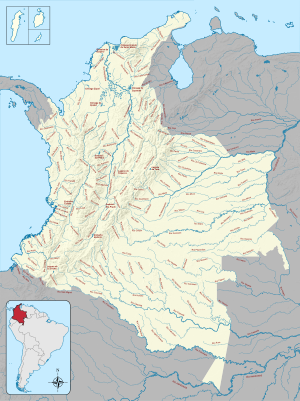Atrato River facts for kids
Quick facts for kids Atrato River |
|
|---|---|
| Country | Colombia |
| Physical characteristics | |
| Main source | Colombia |
| River mouth | Caribbean Sea, Colombia 8°10′45.2″N 76°56′28.7″W / 8.179222°N 76.941306°W |
| Length | 750 km (470 mi) |
| Basin features | |
| Basin size | 37,810 km2 (14,600 sq mi) 35,996.7 km2 (13,898.4 sq mi) |
| Tributaries |
|
The Atrato River (which means Río Atrato in Spanish) is a very important river in northwestern Colombia. It starts high up in the Western Mountains and flows mostly north. It ends in the Gulf of Urabá, where it forms a big, swampy area called a delta.
The river flows through the Chocó Department. In some places, it even forms the border between Chocó and the nearby Antioquia. The Atrato River is about 650 km (400 mi) long. Boats can travel on it for about 400 km (250 mi), all the way to Quibdó, which is the capital city of the Chocó region.
About the Atrato River
The Atrato River basin is the area of land that drains into the river. This area covers about 37,810 km2 (14,600 sq mi). It gets a lot of rain, usually more than 5,000 mm (about 16 feet) every year. In some parts of the upper river, it can rain as much as 12,000 mm (almost 40 feet) per year!
The river flows through a narrow valley between mountains and a coastal area. Because of this, it only has short rivers that flow into it, called tributaries. The main ones are the Truandó, the Sucio, and the Murrí rivers.
Along some parts of the river, there are mines for gold and platinum. The sand in the river also contains gold. Sadly, mining and the harmful waste it creates have damaged the river and its environment. This pollution hurts many plants and animals that live there. It also affects the people who live along the river, especially Afro-Colombian and Native American communities. For many people in the Chocó region, the river is one of the main ways to travel.
Northwestern Colombia is home to many different kinds of wildlife. A long time ago, during the Pleistocene Ice Age, the area where the Atrato River met the Cauca and Magdalena rivers was covered by the sea. Scientists believe this created a natural barrier. This barrier might have caused different animal species to develop separately over time. For example, some scientists think that two types of monkeys, the cotton-top tamarin and the white-footed tamarin, became different species because of the Atrato River. Today, the river still largely separates these two groups of monkeys.
River History and Rights
In the 1800s and early 1900s, people were very interested in the Atrato and San Juan rivers. They thought these rivers could be part of a possible route for a canal across Colombia. A British engineer named William Kennish suggested building a special water bridge, called an aqueduct, using the Atrato River and its tributary, the Truando River. He even led a US military trip to explore this idea.
However, in 1901, the United States government decided the Atrato River was not good for a canal. The route was too long (over 100 miles), and the river carried too much mud and dirt. They decided that Nicaragua and Panama were better places for a canal.
In November 2016, something very important happened. The Constitutional Court of Colombia decided that the Atrato River has its own legal rights. This means the river has rights to be protected, kept healthy, and restored. Even though the Colombian Constitution doesn't directly say rivers have rights, the judge ruled that these are "biocultural rights." This means the river's health and the cultural rights of the people living along it are connected.
This ruling happened because the river was being badly damaged by large-scale mining and illegal logging (cutting down trees illegally). These activities were harming the traditional ways of life for Afro-Colombians and Indigenous people. Illegal logging changed how the river flowed, and illegal mining put harmful chemicals like mercury into the water. This threatened the amazing biodiversity (all the different living things) in the area and hurt the health of the local communities, including children.
The court looked at what New Zealand did when it recognized the Whanganui River's legal rights. Following this example, the Colombian court ordered the creation of a special group called the Commission of the Guardians of Atrato River. This group represents the river's interests and helps manage its resources in a way that keeps the river healthy. At first, the group was supposed to have government members and one community representative. But the local communities asked for more representatives, and now there are fourteen community members on the council, which was formed in May 2018.
Fauna
Fish
- Andinoacara biseriatus - This is a type of fish called a Cichlid.
Images for kids
See also
 In Spanish: Río Atrato para niños
In Spanish: Río Atrato para niños





